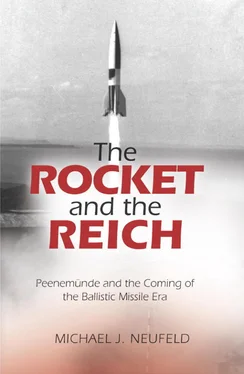Michael Neufeld - The Rocket and the Reich
Здесь есть возможность читать онлайн «Michael Neufeld - The Rocket and the Reich» весь текст электронной книги совершенно бесплатно (целиком полную версию без сокращений). В некоторых случаях можно слушать аудио, скачать через торрент в формате fb2 и присутствует краткое содержание. Город: Washington, Год выпуска: 2013, ISBN: 2013, Издательство: Smithsonian Books, Жанр: История, military_weapon, на английском языке. Описание произведения, (предисловие) а так же отзывы посетителей доступны на портале библиотеки ЛибКат.
- Название:The Rocket and the Reich
- Автор:
- Издательство:Smithsonian Books
- Жанр:
- Год:2013
- Город:Washington
- ISBN:978-1-58834-466-3
- Рейтинг книги:3 / 5. Голосов: 1
-
Избранное:Добавить в избранное
- Отзывы:
-
Ваша оценка:
- 60
- 1
- 2
- 3
- 4
- 5
The Rocket and the Reich: краткое содержание, описание и аннотация
Предлагаем к чтению аннотацию, описание, краткое содержание или предисловие (зависит от того, что написал сам автор книги «The Rocket and the Reich»). Если вы не нашли необходимую информацию о книге — напишите в комментариях, мы постараемся отыскать её.
The Rocket and the Reich — читать онлайн бесплатно полную книгу (весь текст) целиком
Ниже представлен текст книги, разбитый по страницам. Система сохранения места последней прочитанной страницы, позволяет с удобством читать онлайн бесплатно книгу «The Rocket and the Reich», без необходимости каждый раз заново искать на чём Вы остановились. Поставьте закладку, и сможете в любой момент перейти на страницу, на которой закончили чтение.
Интервал:
Закладка:
The real technical achievements of the rocket group assembled by Becker, Dornberger, and von Braun were a further necessary condition for the program’s growth; increased investment in turn assured that more technological successes would be possible. Especially noteworthy is the revolutionary breakthroughs in key technologies that von Braun’s engineers achieved between 1936 and 1941. By building up a massive, secret in-house development capability and by adding university and corporate research and development resources after the outbreak of the war in 1939, Peenemünde was able to prove that it could make the guided missile a reality.
The conflicting demands of the war and the accelerating decline of the Army’s power in the Reich, however, brought the further growth of the rocket program into doubt after late 1939. Under the leadership of Army Commander-in-Chief von Brauchitsch, an acquaintance of Dornberger, the senior service therefore had to exploit what was left of its autonomy and political clout to protect its pet project. Despite innumerable and demoralizing priority crises, the Army leadership by and large succeeded in minimizing politically induced delays to A-4 development, if not to the construction of Dornberger’s ill-advised Peenemünde Production Plant. But the approval and execution of missile mass production came to depend more and more on the new Armaments Ministry and, above all, on the whims of the Führer.
Fortunately for the program, Albert Speer was a Peenemünde enthusiast. Even more important, after August 1941, and especially after November 1942, Adolf Hitler became increasingly infatuated with the A-4’s potential for rescuing Germany from the catastrophic strategic situation he had created. Believing that terror could be answered only with terror and that the regime needed to exact “vengeance” for the strategic bombing of Germany, Hitler readily accepted the arguments of Dornberger and other advisers that the British populace would easily succumb to psychological pressure. Army assertions that there was an international missile race that Germany could ill afford to lose—something that Becker and Dornberger had argued since the early 1930s—gave Hitler yet another reason to approve A-4 production in late 1942. Once that decision was made, no further arguments were really needed to justify the rocket program. Barring an insurmountable technical problem, the development, production, and deployment of the ballistic missile would become a fact, however illogical and “early” that might be.
The Führer’s endorsement, in combination with the Army’s decline, greatly strengthened the role of the Armaments Ministry, but it also brought another power into the program: the SS. Heinrich Himmler, in his relentless empire-building, tried and eventually succeeded in grabbing large pieces of the rocket program. But not all the impetus came from the SS. Problems finding a production labor force in the face of severe manpower shortages also drew the program’s senior managers quite voluntarily into the exploitation of SS concentration camp labor. That fact raises a final key question about the rocket program: How “Nazi” was it or, less crudely put, how much influence did the ideology and practices of National Socialism have on Peenemünde and the program?
The most “Nazi” aspect of the Army rocket program was, in fact, the employment of slave labor in A-4 production, even though the decision to do so was a 1943 improvisation. The exploitation of concentration camp prisoners in the war economy was entirely typical of the Third Reich after 1942, and it was rooted in a Nazi racial hierarchy that many Germans took for granted. By contrast, nothing in the original conception of the program or its technology had identifiably National Socialist ideological roots; Becker’s and Dornberger’s military ideas originated in the thinking of the ultraconservative Weimar officer corps, and their technological enthusiasm for rocketry was bolstered by the spaceflight movement of that era. The rapid adoption of Peenemünde’s technology and even its engineering management structures by foreign powers after World War II also suggests that slave labor was the one uniquely “Nazi” aspect of the rocket program.
Yet looking at the problem in this way would be misleading. The leap at such an early date from small-scale rocket research to a massive program would not have occurred without National Socialism; Peenemünde grew and flourished under Hitler because of the very nature of his regime. As a result, the rocket program built an institution and a weapon that made little sense, given the Reich’s limited research resources and industrial capacity—a perfect symbol of the Nazis’ pursuit of irrational goals with rational, technocratic means.
The top leaders of the program also compromised themselves thoroughly with National Socialism in order to achieve their technical goals. Immediately after the seizure of power, Becker and his subordinates quite willingly used the new police state to suppress the amateur rocket groups, with the aim of creating, in modern military parlance, a super-secret “black program.” Another case was Wernher von Braun, who essentially made a pact with the devil in order to build large rockets. Although he became disillusioned toward the end of the regime, that did not alter his basic motivations; after the war he bore proudly the nominal reasons for his arrest—putting spaceflight before military missile work—but there is no evidence that he ever stuck his neck out for the concentration camp prisoners before his arrest, nor did he show any obvious pangs of conscience about their fate until the 1960s and 1970s, when protests by French prisoner survivors forced him to confront the issue more directly.
The German Army rocket program was thus greatly influenced by—and integrated into—the structures and practices of the Nazi regime, whatever its ideological and technological origins. The ease with which its military and civilian leadership became involved in mass slavery in order to achieve technical and military ends is certainly one of Peenemünde’s most troublesome legacies to the world. But a much more ambiguous legacy was the big rocket itself. The A-4/V-2 was and is the grandfather of all modern guided missiles and space boosters. Some of its successors—the Redstone, the Saturn V, the R-7 Semyorka , and the Ariane—have put application satellites into space, scientific instruments on the planets, and humans on the face of our nearest celestial neighbor. At the same time, the A-4’s successors have threatened us for fifty years with nearly instantaneous nuclear destruction, and will continue to do so, despite the end of the Cold War. Starting from unlikely, even utopian origins in the Weimar spaceflight movement, and ending even more strangely with ineffective weapons and emaciated slaves, the German Army rocket program and its Peenemünde center without a doubt changed the face of the twentieth century.
Appendix 1
The German Army Ordnance Liquid-Fuel Rocket Series
A-1
The first Aggregat was Wernher von Braun’s initial attempt at building a liquid-oxygen/75% alcohol rocket vehicle. Powered by a nominal 300-kg-(660-lb)-thrust engine, it featured a large stabilization gyro in the nose. It was abandoned in favor of the A-2 in early 1934.
A-2
The redesign of the A-1 entailed moving the gyro to the middle of the rocket in order to increase stability in flight and to separate the two propellant tanks. Two A-2s, Max and Moritz , were successfully launched in December 1934. Their initial weight (107 kg, or 235 lb), length (1.61 m or 5.3 ft), and diameter (31.4 cm, or 1 ft) were about the same as the A-1.
A-3
Designed and built 1935–37, four A-3s were launched in December 1937, but all failed because of guidance system inadequacies. Powered by a nominal l,500-kg-(3,300-lb)-thrust engine, they were 6.5 m (22 ft) long and 0.7 m (2.3 ft) in diameter, with a fueled weight of 750 kg (1,650 lb).
Читать дальшеИнтервал:
Закладка:
Похожие книги на «The Rocket and the Reich»
Представляем Вашему вниманию похожие книги на «The Rocket and the Reich» списком для выбора. Мы отобрали схожую по названию и смыслу литературу в надежде предоставить читателям больше вариантов отыскать новые, интересные, ещё непрочитанные произведения.
Обсуждение, отзывы о книге «The Rocket and the Reich» и просто собственные мнения читателей. Оставьте ваши комментарии, напишите, что Вы думаете о произведении, его смысле или главных героях. Укажите что конкретно понравилось, а что нет, и почему Вы так считаете.












